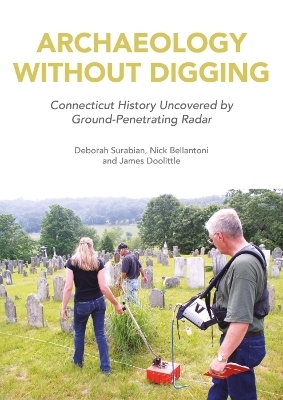
Archaeology Without Digging
Oxbow Books (Verlag)
978-1-78925-926-1 (ISBN)
Over the last 30 years, the Connecticut Office of State Archaeology and the Department of Agriculture’s Natural Resource Conservation Service have entered into a partnership employing ground-penetrating radar (GPR) to the study of the state’s archaeology and history. As a result, many historical cemeteries and places of note in Connecticut have been investigated. The authors have selected 10 geophysical surveys, which have used GPR as a non-intrusive, non-destructive exploratory tool, that have elicited positive results in the search for unmarked burials, confirmation of marked burials and to authenticate areas of known historical events.This book narrates the stories of GPR studies at 10 historical sites in Connecticut, spanning the 17th to the 20th centuries. Each chapter investigates and highlights a ‘history mystery’ and differing aspects of our research, including the ‘lost’ grave of an African-American Revolutionary War veteran, the verification of French Revolutionary War military personnel in a mass grave, the detection of a below-ground hidden 19th-century family burial tomb, the discovery of hurriedly dug, unmarked burials associated with the 1918 influenza pandemic and the detection of the unknown location of a 1941 military plane crash site, among others.Professionally, the authors have over 40 years’ experience in GPR, soil science and archaeology. They bring their collective expertise to the reader in a scientific approach with a personal, story-telling touch. Each chapter delves into the history of the sites and the nature of the geophysical search (i.e., how the equipment was used) and the interpretation of the data in regard to solving a historical problem.
Deborah Surabian is an ARCPACS Certified Professional Soil Scientist. She is experienced with describing, classifying, mapping and interpreting terrestrial, anthropogenic and subaqueous soils. Her skills include identifying natural versus disturbed soils and conducting ground-penetrating radar archaeological and forensic investigations. Nick Bellantoni serves as Emeritus State Archaeologist with the Connecticut State Museum of Natural History and Adjunct Associate Research Professor in the Department of Anthropology at the University of Connecticut. He is a former President of the Archaeological Society of Connecticut and the National Association of State Archaeologists. James Doolittle is a retired Research Soil Scientist formerly with the USDA Natural Resources Conservation Service (NRCS). He was a lead technical advisor to NRCS and other federal, state, county and private agencies on ground-penetrating radar (GPR) and electromagnetic induction (EMI) methods, working with GPR since 1981 and EMI since and 1988.
Introduction
1. Ground-penetrating Radar and Archaeology
Part I. Historical Cemeteries
2. Robinson Burying Ground (1814 Bomb Crater), Stonington
3. Old Norwichtown Burying Ground (French Soldiers), Norwich
4. Judea Cemetery, Washington
5. Stone-lined Tomb, North Burying Ground, Danbury
Part II. Historical Places and Events
6. John Mason’s House, Palisado, Windsor
7. Barkhamsted Lighthouse Village, Barkhamsted
8. Battle of Essex (War of 1812) Riverfront, CT River Museum, Essex
9. A Pandemic Strikes, Old Farm Cemetery, Middletown
10. Second Lieutenant Eugene Bradley’s Plane Crash, Windsor Locks
| Erscheinungsdatum | 12.05.2023 |
|---|---|
| Zusatzinfo | B/w and colour |
| Verlagsort | Oxford |
| Sprache | englisch |
| Maße | 170 x 240 mm |
| Themenwelt | Geisteswissenschaften ► Archäologie |
| Geisteswissenschaften ► Geschichte ► Regional- / Ländergeschichte | |
| ISBN-10 | 1-78925-926-6 / 1789259266 |
| ISBN-13 | 978-1-78925-926-1 / 9781789259261 |
| Zustand | Neuware |
| Informationen gemäß Produktsicherheitsverordnung (GPSR) | |
| Haben Sie eine Frage zum Produkt? |
aus dem Bereich


